Early Season Retriever Safety

By Bill Miller
The conditions and terrain most dogs encounter during the early duck season are significantly different than on other opening days, such as a dove hunt in a hot, dry field. Nor do duck dogs put on the dry, dusty miles of bird dogs in the prairie states hunting pheasants, quail or sharptails.
Even so, duck dogs often encounter their own potentially dangerous brand of opening-day stress, driven by the sun, the heat, the water and an off-season of reduced activity. As the guy or gal responsible for the dog’s health and well-being, you need to know what to watch out for and how to deal with it if a dangerous situation develops. Here are some key health risks to be aware of until the weather turns colder.
Beat the Heat
Unless your opening day finds you and your dog field-hunting somewhere, perhaps for resident honkers, duck dogs generally do not encounter heat-induced problems outside of summer training — with one exception.
Even in Canada, Minnesota, or North Dakota, opening day and even the first couple weeks of the season can come with temperatures poking into the 90s. In a marsh next to a pothole, or set up in the swamp, that can create lots of humidity. Sticky and steamy, you might call it.
Further, the most prevalent Labrador color is black, which pulls and holds heat. Just lying on the deck of a duck boat waiting to make a retrieve in those conditions can stress a black dog, especially one that isn’t in peak condition. Remember, just like you, the dog is probably used to lying around an air-conditioned house the majority of the past months.
Panting — every dog’s primary cooling mechanism — is not as efficient in these conditions. Through panting, the dog inhales copious amounts of cooler-than-body-temperature air and exhausts warmed, moistened air on the exhale. The warmer and moister the air the dog inhales, the less effective panting is as a cooling system.
Your primary cooling mechanism is sweating. Heat is pulled away from your body as perspiration evaporates. However, your dog only sweats minimally from the pads on its feet, which affords minimal cooling. Still, you can help your dog by providing similar evaporation to what’s experienced through sweating.
Keep all the thinly furred areas of the dog’s body wet. The largest and most important is the dog’s underbelly and the insides of its legs — the armpits, if you will. You can also use a spray bottle, if the dog will tolerate it, to keep its ears moistened.
Trying to keep the dog wet all over, rather than in just these key places, is generally less effective and may even be detrimental to overall cooling. If you watch a dog go through its instinctive routine, you’ll see it lie down on its belly in a puddle or pool to stay cool rather than rolling in the water. It’s probably trying to tell us something. For trainers who train through the hottest summer months, a kiddy pool with a few inches of water in the bottom is a standard part of the field gear.
Beware Toxic Algae
Stretches of hot, dry weather can make ponds, lakes and even streams and rivers dangerous for dogs to drink or even swim in. All duck dog owners should know about the dangers of blue-green algae, which cropped up in a big way in 2019. Its toxins are often fatal to dogs that ingest them, and it can kill them quickly.
The trouble is, dangerous varieties of algae are difficult to identify. It’s challenging to look at algae in the water and say, “That’s safe algae and that’s killer algae.” In fact, blue-green algae isn’t really an algae at all. In high concentrations, it sort of looks like algae or oil or paint floating on the water. Sure identification requires water samples be sent off for testing. By then, an exposed dog is dead.
So, if you have any question about the water in your favorite slough — do not hunt the dog! In fact, don’t let the dog anywhere near it. Thankfully, most toxic-algae blooms have subsided by the core of the hunting season, but it’s not uncommon to experience them on opening day or the first few weeks.
Symptoms of blue-green algae poisoning occur anywhere from 15 minutes to a couple of days after ingesting toxic water. They include diarrhea or vomiting, drooling, weakness, disorientation, collapse, unconsciousness, seizures and breathing difficulty. If you see any of these signs, get your dog to the vet — fast! If caught early enough, the vet may be able to flush the toxins from the dog’s system before they cause liver failure, which is how blue-green algae poisoning kills.
Provide Clean Water
It should go without saying, but your dog will do best in hot weather with unlimited access to pure, clean drinking water. Even if the water you’re hunting over isn’t hosting toxic algae, there can be other contaminants that are less than good for your dog.
Whenever and wherever he is hunting or competing with his dogs, pro trainer Jerry Sather of Labs Unlimited Kennels makes it a point to bring ample water from his well at home — the water his dogs are used to drinking every day. Sather feels that keeping his dogs on the same water and same diet on the road gives them an advantage — one less stress that could hamper peak performance.
You’ll often hear the advice to give your dog drinks with extra electrolytes during hot weather and periods of stress. However, this is not universally accepted. Because dogs do not sweat, they do not lose electrolytes from the skin the way people do. Many experts say plain, clean, cool water is the best aid to cooling dogs through panting.
If your dog is experiencing dehydration from vomiting or diarrhea, providing additional electrolytes may be advisable, but you should try to check with your vet before doing so. If you elect to boost electrolytes, use either human infant formula like Pediasure or one specifically designed for dogs. Gatorade and other sports drinks have too many electrolytes for canines and can actually cause worse problems when given to dogs.
When in doubt, go back to basics — unlimited access to clean drinking water.
In doing so, you’ll help keep your retriever safe and happy over the first couple weeks of duck hunting. Fortunately the warm-weather health risks noted should fade away as the season wears on, the days grow colder, and big flocks of ducks and geese head south!

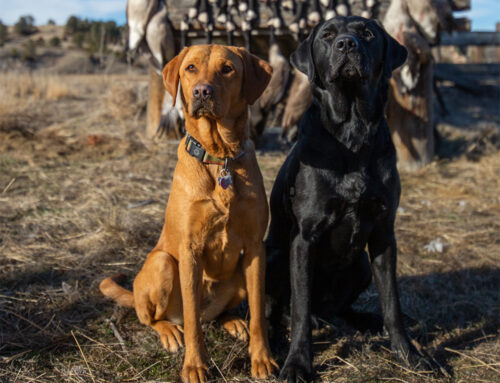
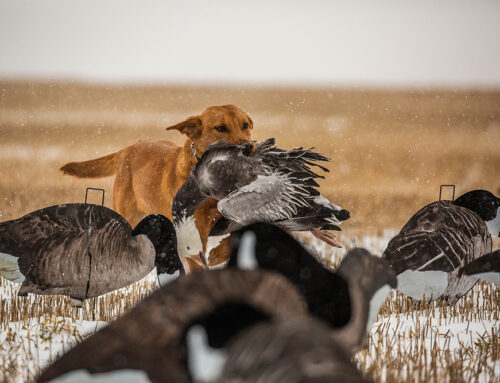
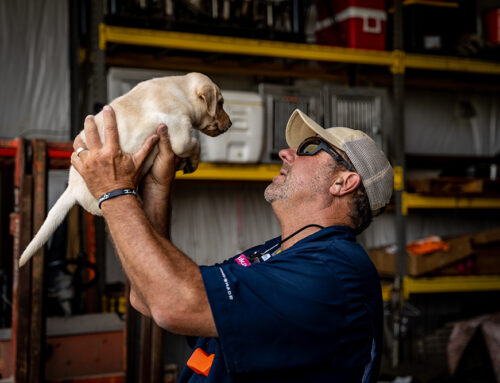
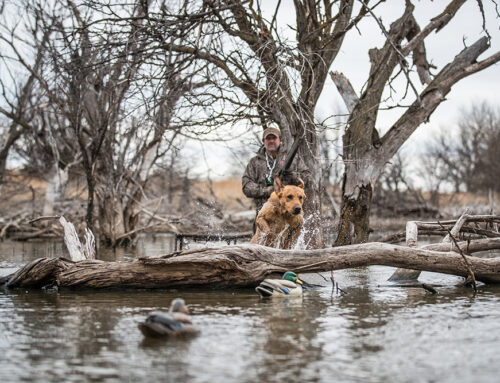
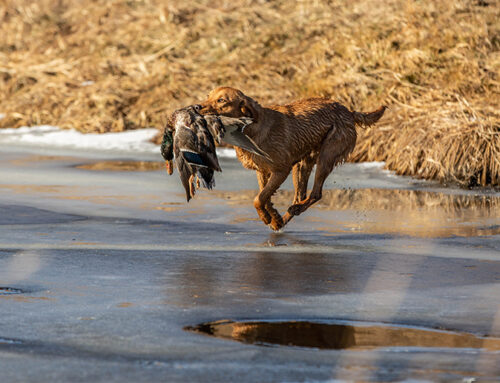
Leave A Comment